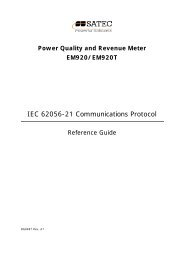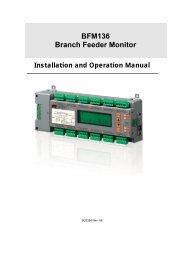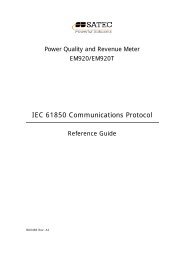You also want an ePaper? Increase the reach of your titles
YUMPU automatically turns print PDFs into web optimized ePapers that Google loves.
of the Modicon 584, 884 or 984 Programmable Controller, using a 5-digit “4XXXX” or 6-digit<br />
“4XXXXX” addressing scheme.<br />
To map the <strong>BFM136</strong>/036 register address to the range of the <strong>Modbus</strong> holding registers, add a<br />
value of 40001 to the device register address. When a register address exceeds 9999, use a 6digit<br />
addressing scheme by adding 400001 to the <strong>BFM136</strong>/036 register address.<br />
2.6 Submeter Addressing<br />
Each active submeter in the <strong>BFM136</strong>/036 is assigned a unique communication address that<br />
allows accessing its private registers and setups. A separate <strong>Modbus</strong> address is engaged for<br />
each submeter for which at least one current input is allocated in the Channel Assignments<br />
Setup (see Section 3.7), and for each additional submeter, which is allocated as a target in the<br />
Billing/TOU Registers Source Setup (see Section 3.7).<br />
The <strong>BFM136</strong>/036 can occupy up to 40 contiguous addresses starting with the device reference<br />
address. All submeter addresses are assigned automatically in a sequential order starting from<br />
the device base address that is programmed through the device Communication Setup. The<br />
following table illustrates submeter addressing in the device with the base address N.<br />
8<br />
Device Base Address Submeter Number Submeter Address<br />
N<br />
SM 1 N<br />
SM 2<br />
…<br />
N+1<br />
SM 36 N+35<br />
SM 37<br />
…<br />
N+36<br />
SM 40 N+39<br />
Your device is factory preset to address 1 and occupies the range of addresses 1 through 12,<br />
configured for 12 three-phase submeters.<br />
NOTE<br />
Device setup settings, excluding the alarm setpoints and data log setup, are shared<br />
across all submeters. Though you can read/write them using any submeter address,<br />
your changes affect all submeters in the device. Note that the communication port<br />
setup may only be changed via the device base address.<br />
Select your submeters (both metering and totalization) in a sequence without gaps so that your<br />
device would not occupy unnecessary network addresses.<br />
If you connect a number of devices to a serial network, allocate a range of addresses for each<br />
device so that they do not overlap. For example, if you use three devices with 12 submeters in<br />
each one, assign the base address 1 to the first device, the address 13 to the second, and the<br />
address 25 to the third device so that they will occupy three non-overlapped address ranges 1<br />
through 12, 13 through 24, and 25 through 36.<br />
2.7 Data Formats<br />
The <strong>BFM136</strong>/036 uses two data formats to pass data between a master application and the<br />
instrument: 16-bit short integer and 32-bit long integer formats. Binary values and counters are<br />
always transmitted in 32-bit registers, while analog values can be read both in 32-bit and in 16bit<br />
scaled registers.<br />
2.7.1 16-bit Scaled Integer Format<br />
16-bit scaled analog data is transmitted in a single 16-bit <strong>Modbus</strong> register being scaled to the<br />
range of 0 to 9999. To get a true reading, a reverse conversion should be done using the<br />
following formula:<br />
where:<br />
X × ( HI − LO)<br />
Y =<br />
+ LO<br />
9999





